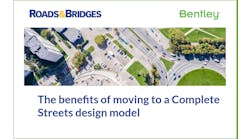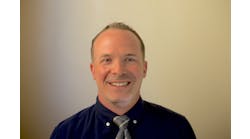As more of the major metropolitan interstate and mass transit systems come up for redesign, the need to control and mitigate noise from construction activity will become critical. One of these major redesign projects is taking place in a densely populated area of Denver, and the need to control noise, particularly at night, has been crucial to the ongoing success of the project.The Denver redesign is being done under a noise variance granted by the city, and two of its major requirements are nighttime noise monitoring and construction equipment certifications. Therefore, the project has become an excellent source for collecting data on environmental noise conditions and construction equipment noise levels. Many innovative mitigation techniques such as the implementation of mobile sound trailers and a 24-hour community noise hotline have been employed with great success and have minimized noise concerns in the local community.
The Denver redesign project should be the blueprint that all new metropolitan construction projects follow for noise control, and with the correct measures local community and government concerns about noise can be minimized and a mutually beneficial relationship can be obtained.
Never an off day
Transportation Expansion Project (T-REX) is the label for the design-build highway and light-rail transportation project being undertaken by Colorado Department of Transportation (CDOT) and the Regional Transportation District (RTD) in the southeast metropolitan area of Denver. The primary contractor for T-REX is Southeast Corridor Constructors (SECC), a joint venture company created by Kiewit and Parsons.
Being a large-scale construction operation, T-REX’s scope of construction activity is very diverse. On a given day, it is quite common to see excavation and grading work, caisson work, embankment work, rail-and-tie setting and drainage and utility work throughout the entire construction corridor. On a monthly basis there is extensive bridge deck construction and asphalt road surface removal. Asphalt and concrete paving are common sights during the summer months. Major construction activities such as bridge concrete deck pours and bridge demolition are scheduled operations that occur every few months.
In order to perform nighttime construction and demolition, a nighttime noise variance had to be approved by the city of Denver’s board of Environmental Health Department (DEH). The written response to the DEH noise variance was the Southeast Corridor Multi-Modal Project’s Noise and Vibration Mitigation and Monitoring plan.
Volume down
The Noise and Vibration Mitigation Plan provides the predicted construction noise and vibration levels at areas adjacent to the construction activity and provides procedures to calculate construction noise levels. It also summarizes construction noise and vibration criteria and describes the noise and vibration mitigation measures that may be applied to meet the noise level limitations.
Denver noise ordinances do not permit nighttime construction activities to exceed 50 dBA or the background noise levels during the hours between 9 p.m. and 7 a.m. The noise variance allowed SECC to conduct construction activities between 9 p.m. and 7 a.m. within variance requirements. The variance established a 75 dBA hourly average noise level (designated as Leq) and an 86 dBA instantaneous maximum noise level (designated as Lmax) for general nighttime construction activities. Nighttime construction is needed on the T-REX project because SECC is required to keep three lanes of traffic open in each direction on I-25 between 5:30 a.m. and 7 p.m. Nighttime construction also is critical to reduce daytime traffic congestion, mitigate potential adverse impacts to air quality and meet the project completion date of September 2006.
The intent of the variance is to keep the nighttime construction noise to a minimum. Therefore, all general nighttime activity has occurred behind an existing sound barrier, regardless of what noise levels are generated. Existing sound barriers include temporary sound walls, temporary sound curtains, permanent sound walls and sound trailers. In addition, all general nighttime construction activity must be reviewed ahead of time to make sure noise is minimized at the work site. Finally, nighttime construction cannot occur more than five consecutive nights at a particular location; there must be two nights of non-work before nighttime work can continue.
The final aspect of the variance is nighttime noise monitoring and data collection. Noise technicians monitor every nighttime construction activity and data is collected weekly and sent to DEH. All of these variance points have been addressed and integrated into SECC’s noise variance compliance program.
The nighttime noise variance was awarded to SECC because of its commitment to best management practice (BMP) for noise mitigation. SECC and its subcontractors use standard and innovative noise mitigation measures to fully comply with the noise variance requirements. The duration of certain construction/demolition activities also are limited and rearranged to minimize possible noise impacts. A substantial amount of noise data is being collected to develop a more comprehensive profile of construction noise and to employ various mitigation measures more effectively.
Machine monitoring
Major construction equipment scheduled to be in operation for five or more days on the project must be certified for noise emission compliance. Equipment is tested in six-month cycles, in accordance with the requirements and procedures listed in the noise variance. Noise limits at 50 ft are established for the anticipated major construction equipment for the project. These limits are part of the noise variance. All construction equipment that passes testing receives a verification sticker. Equipment that does not pass noise testing is either repaired until it meets requirements or removed from the project.
Equipment is tested at the work site, when possible, under working conditions or at the construction yard. The noise emission levels are typically measured at a distance of 15 to 25 ft with the sound level meter located 5 ft above the ground. All the measurements are done only when the equipment noise emission levels at the measurement point are at least 6 dBA above background noise levels. Then standard noise versus distance calculation techniques are applied to estimate the noise level at 50 ft, which can then be compared with the limits specified in the variance. All the equipment items that have backup alarms installed also are checked to see if they have a nighttime backup alarm setting.
Over 300 pieces of construction equipment are being used by SECC and approximately 150 pieces of construction equipment being used by subcontractors on the T-REX project that need to be certified every six months. The type of equipment ranges from light plants to excavators. Due to the amount of equipment, environment conditions required for testing the equipment and need for SECC to keep the equipment operating on site, equipment certification has become a very complicated and time-consuming task. However, by setting up testing schedules that take advantage of environmental conditions, such as testing during off-peak traffic hours or testing equipment when it comes off site for scheduled maintenance, work force hours and equipment down time for this task have been minimized. A comprehensive database has been created that includes measured noise levels at the four sides of each piece of equipment with and without backup alarm, their identification and other relevant information as well as pictures of different equipment items.
A plan to be heard
Before a major structure activity, typically a bridge demolition, can be carried out at night, a noise mitigation plan must be presented to the DEH for review and approval. This plan contains results of implementing various BMPs to minimize noise exposure of the nearby residences and displays the areas affected by noise from bridge demolition. The area where the bridge demolition noise will exceed project limits is called the “eligibility zone.” Residents within the eligibility zone are offered a hotel voucher during the nights of the bridge demolition.
During development of the noise mitigation proposal and the variance application, SECC created the unique hotel voucher program to minimize the effects of allowable nighttime noise levels on residents within areas close to bridge demolition activities. The residences were contacted and informed about the hotel voucher program by the SECC public relations department. The hotel voucher program is what allows the exception for the noise variance Leq and Lmax during bridge demolition. Typically a large portion of the affected residences in the eligibility zone decide not to go to hotels during a bridge demolition activity because they consider the mitigated noise levels are acceptable to them.
The eligibility zones are determined by modeling the noise emissions from the construction equipment operating in the bridge demolition area and effects of the noise mitigation provided by the soundwalls and temporary noise barrier placed in the surrounding area.
The first step in determining the eligibility zone is to review the topographic map of the bridge demolition location. Elevations of where the receivers are in reference to work being done help determine both the noise emission level at each representative noise-sensitive receptor area and the transmission loss provided by a given soundwall. The next step in the eligibility zone establishment process is to review the work plan for bridge demolition.
A detailed work plan must be prepared in advance of any bridge demolition for review and approval by project management. It is from these work plans, which contain the list of the equipment being used during the bridge demolition, that the models for the noise impact calculation are generated.
Blanket buffers
One example of providing an innovative and effective technical noise mitigation solution is SECC’s development of temporary mobile sound barriers. SECC specialists reviewed options for temporary sound barriers based on the mobility needs of the project and SECC’s extensive design-build experience. The result was a decision to retrofit cargo trailers with special acoustical blankets. These trailers are nearly 14 ft high by 53 ft long. The special acoustical blankets hang from the bottoms and between the gaps of the trailers; this arrangement reduces noise emissions from under the trailers and between the openings. Once the trailers are lined up next to each other and gaps are closed, they create a continuous effective mobile sound barrier to mitigate construction noise levels in sensitive areas. Each trailer is equipped with a small motor that rolls up the acoustic blankets for transporting trailers from one location to another. This concept had never been tried on a construction project of this type or magnitude.
The trailers were tested in the construction yard to determine their effectiveness for reducing construction noise. The test consisted of using two front loaders, one dozer and an excavator working 30 ft away from a set of mobile sound trailers as a noise source. While equipment was operating, noise measurements were taken at both sides of the trailers. The equipment was then moved away from the sound trailers and the test was repeated. The results of the noise measurement indicate that the average Leq and Lmax drops due to the mobile sound wall are approximately 13 to 16 dBA, respectively. The sound trailers have proved to be extremely effective in reducing noise during bridge demolition operations. SECC is currently deploying 23 of the mobile sound-wall trailers with a total length of 1,200 ft.
Mass measurements
While SECC’s BMP responses to the noise variance have been effective, all this effort would be meaningless without documentation. There are three types of nighttime noise measurements done during each working night between 9 p.m. and 7 a.m. These measurements are: hourly, spot and complaint. Hourly measurements are measurements that record hourly Leq and Lmax for general nighttime construction activity and are taken when the activity begins and are stopped when the activity finishes for the night, and they are taken at the nearest possible property line. Hourly measurements are done for the first five nights at a specific location for all general nighttime construction activity. Once noise levels are measured from a particular activity at the same location for five days and the activity’s Leq and Lmax do not breach the variance’s general nighttime construction limits, hourly measurements are not required and spot measurements may be done instead. Spot measurements are like maintenance measurements; they last at least 20 minutes and are done to make sure established activities are still below the noise variance’s set limits. If the spot measurement is within 1 dBA of the limits, an hourly measurement is started. Complaint measurements are spot measurements taken in response to nighttime complaints received from the affected residences.
SECC has taken over 2,300 noise measurements from monitoring general nighttime construction work for the first 2 1/2 years of this project. It breaks down into 844 hourly measurements, 1,097 spot measurements and 353 complaint measurements, with approximately 1,950 individual hourly measurements or an average of 3 1/2 hours for each hourly measurement. All these measurements have been dated, documented and categorized by location and construction activity. SECC has demonstrated remarkable success in compliance with the noise variance target numbers (Leq = 75 dBA and Lmax = 85 dBA).
Operators available now
As a requirement of the variance, SECC established a 24-hours-per-day, seven-days-per-week Noise Hotline. The Noise Hotline appears as an upfront option for callers in the main T-REX Information Line, immediately following the welcome, Spanish language information and statement of purpose. Callers to the hotline are provided a summary of current nighttime construction activities and then given the option to register a complaint with a “live” project representative. When receiving a noise complaint, the hotline representative first records as much information from the caller as possible, including name, phone number and location of the noise activity. This information is then digitally transmitted via text messaging service to SECC noise technicians as well as local city and county officials.
If a noise complaint is received during ongoing nighttime construction activity, the nighttime noise technician immediately investigates the complaint. If the complaint is construction related, a noise reading is taken at the complaint site to determine if allowable noise levels have been exceeded. In such instances, which have rarely occurred, the nighttime noise technician has authority to suspend work immediately and correct the problem. Once the problem has been corrected the construction activity may continue. All Noise Hotline complaints and corrective actions are documented and transmitted to the city of Denver along with the weekly noise monitoring report.
Decibel dedication
In partnership with the Department of Environmental Health, Denver Public Works and the community at large, SECC initiated a noise control program for the T-REX Project that is setting a new standard for highway and light-rail construction within an urban environment. This is one of the largest ongoing construction-related nighttime noise mitigation programs along a highway within a major metropolitan area. SECC’s nighttime noise program has proven to be successful; noise has been mitigated to a reasonable level, construction and existing noise profiles have been established throughout the T-REX corridor and no definitive correlation to adverse health impacts has been established.
Nighttime noise control requirements for this project are based on the noise variance granted to SECC by the Board of Environmental Health in October 2001. Through the use of various best management practices, SECC was able to comply with all of the requirements set forth in the noise variance. SECC conducts nightly noise monitoring to evaluate the effectiveness of the noise mitigation efforts and has made a concerted effort to include the nighttime noise mitigation program as a discussion item in daily construction activity meetings.
One of the innovative noise control measures used in this project is the use of mobile sound trailers, typical truck containers that have acoustic blankets at the bottom and on the sides. Lined up next to each other, they make an effective soundwall to reduce noise levels from the daily construction activity and bridge demolition. The nature of the accelerated design-build T-REX Project requires constant schedule reviews and modifications, and meetings evaluate the work from both construction and noise mitigation perspectives. Overall, the BMPs employed by SECC for the T-REX Project have become a cost-effective and rapid response solution to localized noise impact dilemmas.


